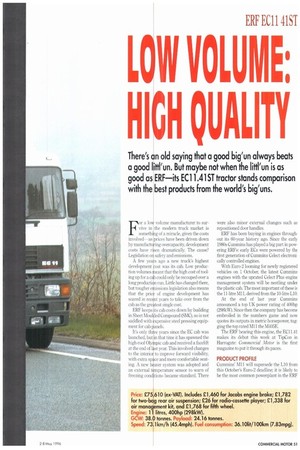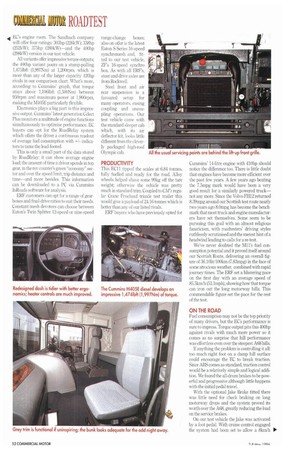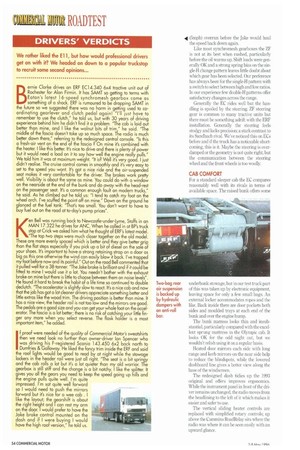IOW V OLU M
Page 55

Page 56

Page 58

Page 59

If you've noticed an error in this article please click here to report it so we can fix it.
NIGH QUALITY
For a low volume manufacturer to survive in the modern truck market is something of a miracle, given the costs involved—as prices have been driven down by manufathiring overcapacity, development costs have risen dramatically. The cause? Legislation or safety and emissions.
A few years ago a new truck's highest development cost was its alb. Low production volumes *leant that the high cost of tooling up for a cab could only be recouped over a t long producti n run. Little has changed there, but tougher el issions legislation also means that the price of engine development has soared in recent years to take over from the cab as the grei.st single cost.
ERF keeps its cab costs down by building in Sheet Moulded Compound (SMC), so is not saddled with expensive steel pressing equipment for cab Panels.
It's only three years since the EC cab was launched, but in that time it has spawned the high-roof OlyUmic cab and received a facelift at the end of st year. This involved changes to the interio to improve forward visibility, with extra sp cc and more comfortable seating. A new h ater system was adopted and an external mperature sensor to warn of freezing con tions became standard. There were also minor external changes such as repositioned door handles.
ERE has been buying in engines throughout its 60-year history ago. Since the early 1980s Cununins has played a big part in powering EREs: early ECs were powered by the first generation of Cummins Celect electronically controlled engines.
With Euro-2 looming for newly registered vehicles on 1 October, the latest Cummins engines with the uprated Celect Plus engine management system will be nestling uncler the plastic cab. The most important of these is the 11-litre M11, derived from the 10-litre Lb.
At the end of last year Cummins announced a top UK power rating of 400hp (298kW). Since then the company has become embroiled in the numbers game and now quotes its outputs in metric horsepower, tagging the top rated NIL the M405E.
The ERF bearing this engine, the EC11,41 makes its debut this week at TipCon in Harrogate: Commercial Motor is the first magazine to put it through its paces.
PRODUCT PROFILE
Cummins' MI 1 will supersede the L10 from this October's Euro-2 deadline; it is likely to be the most common powerplant in the ERF EC's engine room. The Sandbach company will offer four ratings: 303hp (226kW); 338hp (252kW); 375hp (280kW)—and the 400hp (2981cW) version in our test vehicle.
All variants offer impressive torque outputs; the 400hp variant pours on a stump-pulling 1,4751bft (1,9971Cm) at 1200rpm, which is more than any of the larger capacity 420hp rivals in our comparison chart. What's more, according to Cummins' graph, that torque stays above 1,106lbft (1,500Nm) between 950rpm and maximum power at 1,900rpm, making the M405E particularly flexible.
Electronics plays a big part in this impressive output, Cununins' latest generation Celect Plus monitors a multitude of engine functions simultaneously to optimise performance. EC buyers can opt for the RoadRelay system which offers the driver a continuous readout of average fuel consumption with +/indicators to tame the lead-footed.
This is only a small part of the data stored by RoadRelay: it can show average engine load; the amount of time a driver spends in top gear, in the rev counter's green "economy" sector and over the speed limit; trip distance and time—and more besides. This information can be downloaded to a PC via Cummins 1nRoads software for analysis.
ERF customers can opt for a range of gearboxes and final-drive ratios to suit their needs. Constant-mesh devotees can choose between Eaton's Twin Splitter 12-speed or nine-speed range-change boxes; also on offer is the latest Eaton S-Series 16-speed synchromesh and, fitted to our test vehicle, ZF's 16-speed synchro box. As with all ERF's, steer and drive axles are from Rockwell.
Steel front and air rear suspension is a favoured setup for many operators, easing coupling and uncoupling operations. Our test vehicle came with the standard sleeper cab which, with its air deflector kit, looks little different from the cleverly packaged high-roof Olympic cab, This F,C11 tipped the scales at 6.84 tonnes, fully fuelled and ready for the road. Alloy wheels helped shave some 99kg off the tare weight; otherwise the vehicle was pretty much in standard trim. Coupled to CMS regular Crane Fruehauf triaxle test trailer this would give a payload of 24.16 tonnes which is better than any of our listed rivals.
ERF buyers who have previously opted for
Curmnins' 14-litre engine with 410hp should notice the difference too. There is little doubt that engines have become more efficient over the past few years. A few years ago beating the 7.5mpg mark would have been a very good result for a similarly powered truck— not any more. Since the Volvo F1112 returned 8.39mpg around our Scottish test route nearly two years ago 8.0mpg has become the benchmark that most tuck and engine manufacturers have set themselves. Some seem to be pursuing this goal with an almost religious fanaticism, with roadtesters' driving styles ruthlessly scrutinised and the merest hint of a headwind leading to calls for a re-test.
We've never doubted the M1 Fs fuel consumption potential and it proved itself around our Scottish Route, delivering an overall figure of 36.101it/100km (7.83mpg) in the face of some atrocious weather, combined with rapid journey times. The ERF set a blistering pace on the first day with an average speed of 85.5km/h (53.1mph), showing how that torque can iron out the long motorway hills. This commendable figure set the pace for the rest of the test.
Fuel consumption may not be the top priority of many drivers, but the EC's performance is sure to impress. Torque output pits this 400hp against rivals with much more power so it comes as no surprise that hill performance was effortless even over the steepest A68 hills.
If anything the problem is controlling it all: too much right foot on a damp hill surface could encourage the EC to break traction. Since ABS comes as standard, traction control would be a relatively simple and logical addition. We found the all-drum brakes to be powerful and progressive although little happens with the initial pedal travel.
With the optional Jake Brake fitted there was little need for check braking on long motorway drops and the system proved its worth over the A68, greatly reducing the load on the service brakes.
On our test vehicle the Jake was activated by a foot pedal. With cruise control engaged the system had been set to allow a 81un/h
(5mph) overrun before the Jake would haul the speed back down again.
Like most synchromesh gearboxes the ZF is not at its best when rushed, particularly before the oil warms up. Shift loads were generally OK and a strong spring bias on the single-H change pattern leaves little doubt about which gear has been selected. Our preference has always been for the single-H pattern with a switch to select between high and low ratios. In our experience few double-H patterns offer satisfactory changes across the range.
Generally the EC rides well hut the handling is spoiled by the steering. ZF steering gear is common to many tractive units but there must be something adrift with the ERF installation. Generally the steering feels stodgy and lacks precision; a stark contrast to its Sandbach rival. We've noticed this on ECs before and if the truck has a noticeable shortcoming, this is it. Maybe the steering is overdamped or the geometry is not quite right, but the communication between the steering wheel and the front wheels is too woolly For a standard sleeper cab the EC compares reasonably well with its rivals in terms of available space. The raised bunk offers some
Two-bag rear underbunk stowage, but in our test truck part
air suspension of this was taken up by electronic equipment, is backed up leaving space for only a few small bags. An by hydraulic external locker accommodates ropes and the
dampers with like. Back inside there are door pockets both an anti-roll sides and moulded trays at each end of the bar. bunk and over the engine hump.
The bunk matress looks thin and insubstantial, particularly compared with the excellent sprung mattress in the Olympic cab. It looks OK for the odd night out, but we wouldn't relish using it on a regular basis.
Heated door mirrors each side with long range and kerb mirrors on the near side help to reduce the blindspots, while the lowered dashboard line gives a better view along the base of the windscreen.
The redesigned dash tidiesup the 1993 original and offers improves ergonomics. While the instrument panel in front of the driver remains unchanged, the radio moves from the headlining to the left of it which makes it easier and safer to use.
The vertical sliding heater controls are replaced with simplified rotary controls; up above the Cummins RoadRelay sits where the radio was where it can be seen easily with an upward glance. The one hangover from the old design is the multi-function stalk to the right of the steering column. Mercedes-Benz has been the arch exponent of the single ovenvorked stalk but we predict it will finally be consigned to history with the arrival of tile SK.I■1 later this year. Let's hope that both ERF and Foden follow the trend so we shall no longer end up blowing the horn when looking for the wipers.
The grey trim is easy on the eye though uninspiring, but the plastic surfaces look easy to wipe clean. It's not quite up to German or Swedish standard of finish but it's pretty well screwed together and rattle-free.
Barring the soggy steering, there isn't much wrong with this ERE Its performance and fuel consumption do not disappoint and will
appeal to fleet operators and owner-drivers alike. So will the 10-year cab warranty If list price hs any meaning, the ERF is not the cheapest uy at £75,610 (ex-VAT)-an Ml I poweredl Foclen would set you back E70,000. On t other hand most of its other rivals cost mor.
Cummins h s led the way in engine electronics and m nitoring/diagnostics systems: this alone sho ld be a strong selling tool for performanc nscious fleets.
The MI 1 alirady has a strong following in the US. With ich high torque ratings it will satisfy the news of most operators for 38 or 40-tonne work ERF may lack the budgets of some rivals bqt the end result shows that a small manufwiturer can still mix it with the big boys and offer a competitive product.
IL] by John KendalL


































































































































































